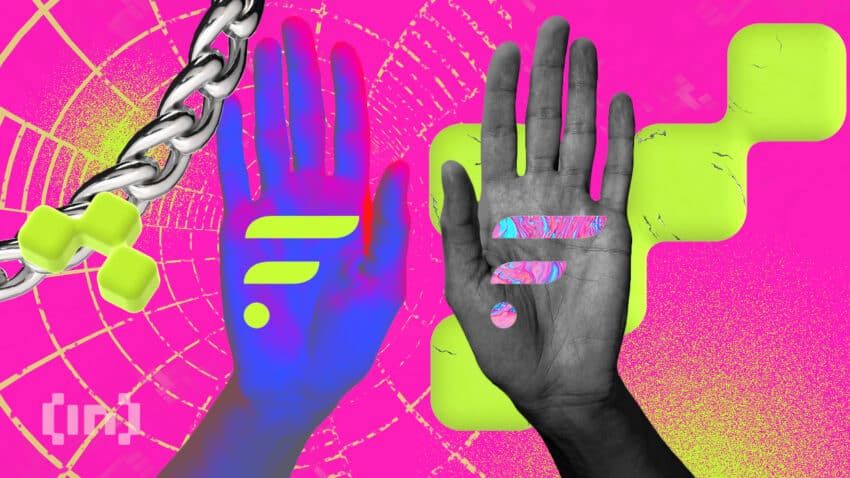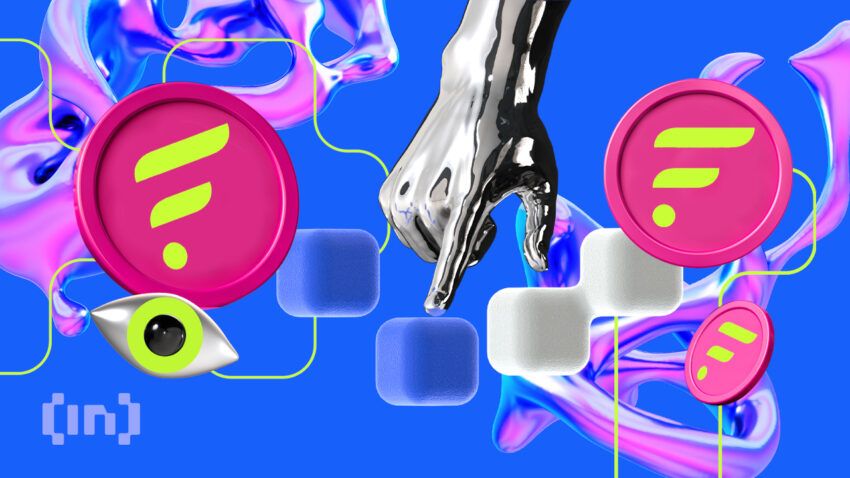There’s a big buzz around the Flare Network and its disruptive potential within the crypto industry. The ecosystem’s popularity has risen partly due to the highly anticipated FLR airdrop. Now that the FLT token has been distributed, the network is officially open for business. So, what do we need to know about Flare? This guide looks at the network in its totality. We cover what the Flare Network is, how it works, its main features, its tokenomics, and its mission. Let’s dive in.
Want to get all the hottest news and reviews on the best crypto projects like Flare network? Join BeInCrypto Trading Community on Telegram: read news, discuss crypto projects, ask for technical analysis on coins and get answers to all your questions from PRO traders & experts! Join now
What is the Flare Network?

The Flare Network is an interoperable layer-1 proof-of-stake blockchain that utilizes the Ethereum Virtual machine (EVM). Flare (FLR) was created in 2020. The aim? To bring smart contract and interoperability capabilities to blockchains.
SponsoredThe Ripple blockchain powered by XRP was one of the main targets and inspirations of the Flare Network. Flare proposes scaling PoS blockchains without compromising their security. It does this by ensuring that the network’s security is not linked solely to its native tokens, as is the case with most, if not all, PoS networks.
Team
Three founders created this ambitious solution. The first is Hugo Philion, who is the CEO of the project. Hugo has a background in portfolio management, with experience working as a commodity derivatives portfolio manager. He also has a Master of Science degree in Machine Learning from UCL, where he met the other co-founders.

Sean Rowan is the second co-founder of the Flare Network. He also attended UCL, earning a Master of Science degree in Machine Learning. Sean has worked on multiple blockchain projects since 2015, including building secure vehicular communications protocols that leveraged blockchain-based public key infrastructure. Currently, he is the Chief Technology Officer at Flare.
Lastly, there is Dr. Nairi Usher. She is the current Chief Scientist at Flare and has a Master of Science in physics and a doctorate in quantum computing from the University College London. Before creating the Flare Network, Dr. Nairi had worked with Siemens to create healthcare applications and image recognition using quantum algorithms.
Besides the co-founders, the Flare Network has a big staff team, ranging from engineers to finance team members to community managers.
Since its creation, the Flare Network team has received funding from many sources. The first chunk of funding came from Ripple in 2019 through its investment arm, Xpring. Later, in 2021, the Flare team received about $11.3 million in a funding round, counting the Digital Currency Group, Kinetic Capital, Ripple, Charlie Lee, and Do Kwan as investors. Currently, the Flare Network has 19 investors.
Roadmap
The Flare Network is delivering on its roadmap with the funding raised so far. A few key milestones already reached are the State Connector’s deployment and Flare’s launch.
Next, there is a governance proposal on token distribution. The proposal aims to ensure future token distribution by removing the risk of an exchange refusing to distribute tokens. It also seeks to provide positive tax implications for users and increase incentives for engaging with the network.
The roadmap also outlines plans for creating the Flare Foundation. This non-profit organization will have responsibilities like research and development, publicity, partnerships, education, investments, grants, and more.
Sponsored SponsoredHow does the Flare Network work?
The Flare Network aims to promote communication and transactions between different blockchain networks and bring smart contracts to alternative networks.
The Flare network functions as a Turing-Complete Byzantine Agreement Network, which uses the Flare Consensus Protocol. Being Turing-complete means that the Flare network can run Turing-complete smart contracts, which can simulate any computer algorithm. This makes it easier for any developer or computer to use any coding language to run smart contracts on the network.
Furthermore, Flare uses the Ethereum Virtual Machine for this smart contract deployment. EVM makes it easier for Ethereum developers to build applications on top of Flare.
To promote interoperability between different blockchains, the Flare network uses two protocols. The first is the State Connector, and the second is the Flare Time Series Oracle (FTSO). The State Connector helps in the acquisition of external data from other blockchains. This data is processed on-chain to provide a consensus on the state of any blockchain Flare connects to.
By doing so, the Flare Network can recreate whatever is happening on the blockchain it connects to. On the other hand, the Flare Time Series Oracle (FTSO) allows for the decentralized acquisition of time-series data. These are collected over a consistent period of time on other blockchains. Data may include things like data indices, asset prices, and more.
The Flare Network can communicate with and exchange data over multiple blockchains through both protocols. This promotes interoperability, especially in application building and usage on different networks.
Flare Network features
Let’s take a look at some of the key features that help the Flare Network function efficiently.
The Ethereum Virtual Machine (EVM)
The Ethereum Virtual Machine (EVM) is software that helps execute and deploy smart contracts on the Ethereum blockchain. It also provides an environment for developers to build decentralized applications (DApps) on the network. In the Flare Network, the EVM plays the same role by executing smart contracts and hosting DApps. This makes the network viable for Ethereum developers.
SponsoredFlare State Connector Protocol
Flare State Connector Protocol is a smart contract allowing the Flare Network to collect data from any connected blockchain. It does this in a decentralized and secure manner using independent attestation providers. These providers independently fetch data from a blockchain of interest. The Flare network publishes this data once there is enough consensus.
Flare Time Series Oracle Protocol (FTSO)
Flare Time Series Oracle Protocol (FTSO) is another cross-chain data collection and validation feature on the Flare Network. As opposed to the State Connector Protocol, FTSO collects time-specific data. FTSO uses independent data providers to ensure data collection is decentralized and secure. The time-specific data may come from places like crypto exchanges. Then, it is automatically weighted depending on the information provider’s voting power. A median is calculated to produce an estimate that can be used on Flare once the data is weighted.
Songbird
Songbird is Flare’s ‘Canary’ network. It is a test/experimental network with the exact same features and functionality as Flare. Here, independent developers and the team from Flare can carry out real-life experiments on a test network. They do this to see how their changes would affect the Flare network. This makes it easier and safer to experiment and deploy suggested changes without the risk of jeopardizing the main network.
Pros and cons of the Flare Network

The first pro of the Flare network is its ability to make blockchains interoperable. This is an advantage for developers and blockchain users as transactions; Flare’s technology allows information to be transferred between multiple blockchains.
Secondly, the Flare networks help PoS blockchains grow without jeopardizing their security. Flare supports this by allowing smart contract platforms to scale without linking the security of the networks solely to their native tokens. The network also provides an environment for building DApps without the worry of code incompatibility due to being Turing-complete. Lastly, by integrating the Ethereum Virtual Machine, Flare further acts to scale up smart contract networks.
Despite its many pros, there are some cons to the network. The main and biggest drawback is Flare’s dependence on the Ripple network. The network delayed its launch and airdrop for two years due to Ripple’s court case. The network will be disadvantaged long term if it continues to be deeply affected by the functions of one blockchain.
Sponsored SponsoredFLR token

The Flare Token (FLR), initially called Spark, is the native token of the Flare Network. FLR use cases include payments, staking in validator nodes, payment of transaction fees, voting, and preventing spam attacks. The Flare token has the ticker FLR and is available for purchase and trade on multiple centralized and decentralized exchanges.
There are 100 billion FLR tokens available to distribute among the network’s key stakeholders. 58% of the tokens will go to the Flare community via airdrops. Then, 19% is allocated to the development team, backers, and advisors. Finally, Flare reserved 22.5% of tokens for product development and investment.
The token distribution event was first scheduled for 2020. Due to the aforementioned Ripple court case, the first airdrop instead occurred in a token distribution event on Jan. 9, 2023. Eligible XRP holders received 4.28 billion FLR via centralized exchanges such as Binance, Kraken, Kucoin, and OKX.
The 4.28 billion FLR airdropped represented 15% of the tokens allocated to the community. The remaining 85% of the token will be distributed depending on the vote of the current holders, who are expected to wrap their FLR tokens.
The network is officially live following token distribution. Other than voting on how the remaining tokens will be distributed, the FLR tokens will be used differently in the network. First, FLR acts as collateral within third-party DApps built on Flare blockchains. It also acts as an incentive to support the provision of reliable decentralized price data through the Flare Time Series Oracle (FTSO). Users pay transaction fees in FLR in order to prevent spam attacks. And as mentioned earlier, the token allows users to participate in the network’s governance. Users will be able to vote on future proposals using FLR.
FLR Network wallet
A range of different crypto wallets supports FLR. OKX, Metamask, Ledger, Ellipal, HexTrust, and Copper are all examples of cryptocurrency wallets that FLR users can utilize to manage their tokens.
All eyes are on the Flare Network and FLR
The much-awaited FLR airdrop and the network going live mark a crucial step forward for the Flare network. Now, all eyes are on the Flare team to deliver the objectives set out in the roadmap. Flare could bring serious benefits to the crypto ecosystem if the network functions as planned. However, time will tell as to how the network functions and how users interact with it and its products.

